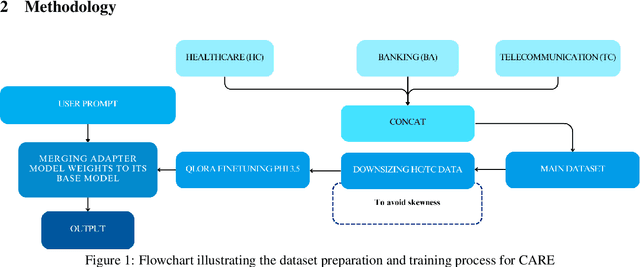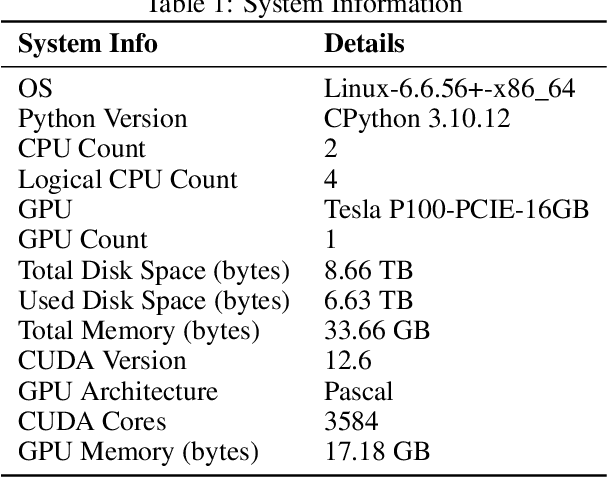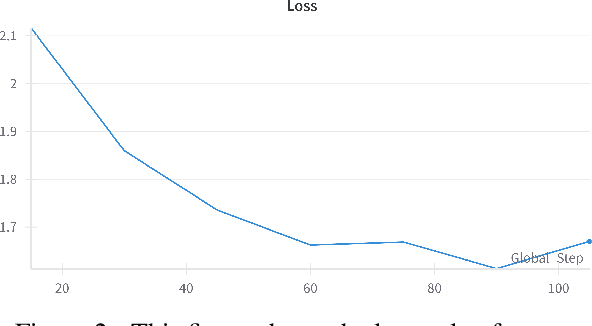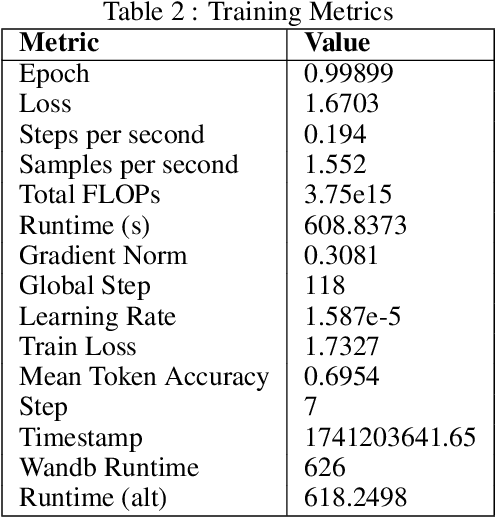chatbots
Papers and Code
Clean & Clear: Feasibility of Safe LLM Clinical Guidance
Mar 26, 2025Background: Clinical guidelines are central to safe evidence-based medicine in modern healthcare, providing diagnostic criteria, treatment options and monitoring advice for a wide range of illnesses. LLM-empowered chatbots have shown great promise in Healthcare Q&A tasks, offering the potential to provide quick and accurate responses to medical inquiries. Our main objective was the development and preliminary assessment of an LLM-empowered chatbot software capable of reliably answering clinical guideline questions using University College London Hospital (UCLH) clinical guidelines. Methods: We used the open-weight Llama-3.1-8B LLM to extract relevant information from the UCLH guidelines to answer questions. Our approach highlights the safety and reliability of referencing information over its interpretation and response generation. Seven doctors from the ward assessed the chatbot's performance by comparing its answers to the gold standard. Results: Our chatbot demonstrates promising performance in terms of relevance, with ~73% of its responses rated as very relevant, showcasing a strong understanding of the clinical context. Importantly, our chatbot achieves a recall of 0.98 for extracted guideline lines, substantially minimising the risk of missing critical information. Approximately 78% of responses were rated satisfactory in terms of completeness. A small portion (~14.5%) contained minor unnecessary information, indicating occasional lapses in precision. The chatbot' showed high efficiency, with an average completion time of 10 seconds, compared to 30 seconds for human respondents. Evaluation of clinical reasoning showed that 72% of the chatbot's responses were without flaws. Our chatbot demonstrates significant potential to speed up and improve the process of accessing locally relevant clinical information for healthcare professionals.
Exploring the Effect of Robotic Embodiment and Empathetic Tone of LLMs on Empathy Elicitation
Mar 26, 2025This study investigates the elicitation of empathy toward a third party through interaction with social agents. Participants engaged with either a physical robot or a voice-enabled chatbot, both driven by a large language model (LLM) programmed to exhibit either an empathetic tone or remain neutral. The interaction is focused on a fictional character, Katie Banks, who is in a challenging situation and in need of financial donations. The willingness to help Katie, measured by the number of hours participants were willing to volunteer, along with their perceptions of the agent, were assessed for 60 participants. Results indicate that neither robotic embodiment nor empathetic tone significantly influenced participants' willingness to volunteer. While the LLM effectively simulated human empathy, fostering genuine empathetic responses in participants proved challenging.
* *Liza Darwesh, Jaspreet Singh, Marin Marian, and Eduard Alexa contributed equally to this work.*
Conversational User-AI Intervention: A Study on Prompt Rewriting for Improved LLM Response Generation
Mar 21, 2025Human-LLM conversations are increasingly becoming more pervasive in peoples' professional and personal lives, yet many users still struggle to elicit helpful responses from LLM Chatbots. One of the reasons for this issue is users' lack of understanding in crafting effective prompts that accurately convey their information needs. Meanwhile, the existence of real-world conversational datasets on the one hand, and the text understanding faculties of LLMs on the other, present a unique opportunity to study this problem, and its potential solutions at scale. Thus, in this paper we present the first LLM-centric study of real human-AI chatbot conversations, focused on investigating aspects in which user queries fall short of expressing information needs, and the potential of using LLMs to rewrite suboptimal user prompts. Our findings demonstrate that rephrasing ineffective prompts can elicit better responses from a conversational system, while preserving the user's original intent. Notably, the performance of rewrites improves in longer conversations, where contextual inferences about user needs can be made more accurately. Additionally, we observe that LLMs often need to -- and inherently do -- make \emph{plausible} assumptions about a user's intentions and goals when interpreting prompts. Our findings largely hold true across conversational domains, user intents, and LLMs of varying sizes and families, indicating the promise of using prompt rewriting as a solution for better human-AI interactions.
ConSCompF: Consistency-focused Similarity Comparison Framework for Generative Large Language Models
Mar 18, 2025Large language models (LLMs) have been one of the most important discoveries in machine learning in recent years. LLM-based artificial intelligence (AI) assistants, such as ChatGPT, have consistently attracted the attention from researchers, investors, and the general public, driving the rapid growth of this industry. With the frequent introduction of new LLMs to the market, it becomes increasingly difficult to differentiate between them, creating a demand for new LLM comparison methods. In this research, the Consistency-focused Similarity Comparison Framework (ConSCompF) for generative large language models is proposed. It compares texts generated by two LLMs and produces a similarity score, indicating the overall degree of similarity between their responses. The main advantage of this framework is that it can operate on a small number of unlabeled data, such as chatbot instruction prompts, and does not require LLM developers to disclose any information about their product. To evaluate the efficacy of ConSCompF, two experiments aimed at identifying similarities between multiple LLMs are conducted. Additionally, these experiments examine the correlation between the similarity scores generated by ConSCompF and the differences in the outputs produced by other benchmarking techniques, such as ROUGE-L. Finally, a series of few-shot LLM comparison experiments is conducted to evaluate the performance of ConSCompF in a few-shot LLM comparison scenario. The proposed framework can be used for calculating similarity matrices of multiple LLMs, which can be effectively visualized using principal component analysis (PCA). The ConSCompF output may provide useful insights into data that might have been used during LLM training and help detect possible investment fraud attempts.
Personalized Attacks of Social Engineering in Multi-turn Conversations -- LLM Agents for Simulation and Detection
Mar 18, 2025



The rapid advancement of conversational agents, particularly chatbots powered by Large Language Models (LLMs), poses a significant risk of social engineering (SE) attacks on social media platforms. SE detection in multi-turn, chat-based interactions is considerably more complex than single-instance detection due to the dynamic nature of these conversations. A critical factor in mitigating this threat is understanding the mechanisms through which SE attacks operate, specifically how attackers exploit vulnerabilities and how victims' personality traits contribute to their susceptibility. In this work, we propose an LLM-agentic framework, SE-VSim, to simulate SE attack mechanisms by generating multi-turn conversations. We model victim agents with varying personality traits to assess how psychological profiles influence susceptibility to manipulation. Using a dataset of over 1000 simulated conversations, we examine attack scenarios in which adversaries, posing as recruiters, funding agencies, and journalists, attempt to extract sensitive information. Based on this analysis, we present a proof of concept, SE-OmniGuard, to offer personalized protection to users by leveraging prior knowledge of the victims personality, evaluating attack strategies, and monitoring information exchanges in conversations to identify potential SE attempts.
CARE: A QLoRA-Fine Tuned Multi-Domain Chatbot With Fast Learning On Minimal Hardware
Mar 18, 2025



Large Language models have demonstrated excellent domain-specific question-answering capabilities when finetuned with a particular dataset of that specific domain. However, fine-tuning the models requires a significant amount of training time and a considerable amount of hardware. In this work, we propose CARE (Customer Assistance and Response Engine), a lightweight model made by fine-tuning Phi3.5-mini on very minimal hardware and data, designed to handle queries primarily across three domains: telecommunications support, medical support, and banking support. For telecommunications and banking, the chatbot addresses issues and problems faced by customers regularly in the above-mentioned domains. In the medical domain, CARE provides preliminary support by offering basic diagnoses and medical suggestions that a user might take before consulting a healthcare professional. Since CARE is built on Phi3.5-mini, it can be used even on mobile devices, increasing its usability. Our research also shows that CARE performs relatively well on various medical benchmarks, indicating that it can be used to make basic medical suggestions.
Broaden your SCOPE! Efficient Multi-turn Conversation Planning for LLMs using Semantic Space
Mar 14, 2025Large language models (LLMs) are used in chatbots or AI assistants to hold conversations with a human user. In such applications, the quality (e.g., user engagement, safety) of a conversation is important and can only be exactly known at the end of the conversation. To maximize its expected quality, conversation planning reasons about the stochastic transitions within a conversation to select the optimal LLM response at each turn. Existing simulation-based conversation planning algorithms typically select the optimal response by simulating future conversations with a large number of LLM queries at every turn. However, this process is extremely time-consuming and hence impractical for real-time conversations. This paper presents a novel approach called Semantic space COnversation Planning with improved Efficiency (SCOPE) that exploits the dense semantic representation of conversations to perform conversation planning efficiently. In particular, SCOPE models the stochastic transitions in conversation semantics and their associated rewards to plan entirely within the semantic space. This allows us to select the optimal LLM response at every conversation turn without needing additional LLM queries for simulation. As a result, SCOPE can perform conversation planning 70 times faster than conventional simulation-based planning algorithms when applied to a wide variety of conversation starters and two reward functions seen in the real world, yet achieving a higher reward within a practical planning budget. Our code can be found at: https://github.com/chenzhiliang94/convo-plan-SCOPE.
MinorBench: A hand-built benchmark for content-based risks for children
Mar 13, 2025Large Language Models (LLMs) are rapidly entering children's lives - through parent-driven adoption, schools, and peer networks - yet current AI ethics and safety research do not adequately address content-related risks specific to minors. In this paper, we highlight these gaps with a real-world case study of an LLM-based chatbot deployed in a middle school setting, revealing how students used and sometimes misused the system. Building on these findings, we propose a new taxonomy of content-based risks for minors and introduce MinorBench, an open-source benchmark designed to evaluate LLMs on their ability to refuse unsafe or inappropriate queries from children. We evaluate six prominent LLMs under different system prompts, demonstrating substantial variability in their child-safety compliance. Our results inform practical steps for more robust, child-focused safety mechanisms and underscore the urgency of tailoring AI systems to safeguard young users.
On the Limitations of Vision-Language Models in Understanding Image Transforms
Mar 12, 2025



Vision Language Models (VLMs) have demonstrated significant potential in various downstream tasks, including Image/Video Generation, Visual Question Answering, Multimodal Chatbots, and Video Understanding. However, these models often struggle with basic image transformations. This paper investigates the image-level understanding of VLMs, specifically CLIP by OpenAI and SigLIP by Google. Our findings reveal that these models lack comprehension of multiple image-level augmentations. To facilitate this study, we created an augmented version of the Flickr8k dataset, pairing each image with a detailed description of the applied transformation. We further explore how this deficiency impacts downstream tasks, particularly in image editing, and evaluate the performance of state-of-the-art Image2Image models on simple transformations.
Proceedings of the ISCA/ITG Workshop on Diversity in Large Speech and Language Models
Mar 12, 2025Machine learning techniques have conquered many different tasks in speech and natural language processing, such as speech recognition, information extraction, text and speech generation, and human machine interaction using natural language or speech (chatbots). Modern techniques typically rely on large models for representing general knowledge of one or several languages (Large Language Models, LLMs), or for representing speech and general audio characteristics. These models have been trained with large amounts of speech and language data, typically including web content. When humans interact with such technologies, the effectiveness of the interaction will be influenced by how far humans make use of the same type of language the models have been trained on or, in other words, if the models are able to generalize to the language used by humans when interacting with the technology. This may lead to some gradual forms of adaptation in human speech and language production, and users who do not adapt may be excluded from efficient use of such technologies. On top of this, as commercial model development follows market needs, under-represented languages and dialects/sociolects may decrease in terms of priorities. Furthermore, for many lesser spoken languages the necessary data is not available, which will worsen a digital divide in speech and language technology usage. The workshop sets out to discuss this problem based on scientific contributions from the perspective of computer science and linguistics (including computational linguistics and NLP).
 Add to Chrome
Add to Chrome Add to Firefox
Add to Firefox Add to Edge
Add to Edge